How to Do Brand Research in Less than 30 Minutes?
Table of contents
At first glance, brand research seems to be as fun as paying taxes and as quick as snails crossing the road. But that’s a myth! Thanks to AI tools, you can conduct fruitful brand research in less than half an hour! Besides, discovering surprising insights about your brand and the hidden opportunities behind them is a lot of fun.
Brand research is a process of discovering your overall brand perception. It involves gathering and processing information about your brand identity, market position, target audience, etc.
In its essence, brand research helps you understand your strengths, weaknesses, opportunities, and threats to guide your strategy and – ultimately – improve your brand’s performance, loyalty, and recognition.
What is brand research? Definition
Generally speaking, brand research is a comprehensive set of actions taken to understand overall brand perception.
It involves all the processes that lead us to see a more authentic and accurate state of our brand, including gathering, analyzing, and interpreting relevant pieces of information.
In other words, brand research helps us see the gap between the idealized brand image and how people actually see us.
Practically, discovering what thoughts and feelings brands recall requires implementing various techniques, such as AI tools research, online surveys, or competitive analysis.
The ultimate goals of brand research are to deeply understand the brand’s perception among our target audience (and, more broadly, target market), identify our strengths and weaknesses, and refine our marketing strategy to enhance brand equity and awareness.
It lets us compare our expectations with the real perceptions out there, giving us a clear picture of where we stand and where we need to step up our game.
It’s time for a brand research! Do it now!
Purposes of brand research
Brand research is very complex, and so it serves multiple purposes:
- Brand recognition, to assess how easily the brand is identified and distinguished from others;
- Brand awareness, to measure how well the target audience knows the brand and its products or services;
- Brand perception, to understand customers’ brand associations, attributes, and emotional connections;
- Brand positioning, to evaluate the brand’s position in the market relative to competitors;
- High brand loyalty, to assess the level of customer loyalty and satisfaction with the brand;
- Brand equity, to measure the value of the brand in terms of financial performance, brand perceptions, and market success;
- Competitive analysis, to identify key competing brands, opportunities, threats, and target market dynamics;
- Brand messaging, to evaluate the effectiveness of brand messages and communications;
- Brand advocacy, to understand and enhance how willing customers are to recommend the brand to others.
Try the best brand research tool!
How to do brand research?
If you’re looking for super-advanced brand research techniques reserved only for gray-bearded analytics with 40 years of experience and require specialistic tools for 20,000 USD per month – nah, that’s not here, fellow!
Instead, I want to show you three really simple but effective brand research methods that anyone can do at low or no cost. Here we go!
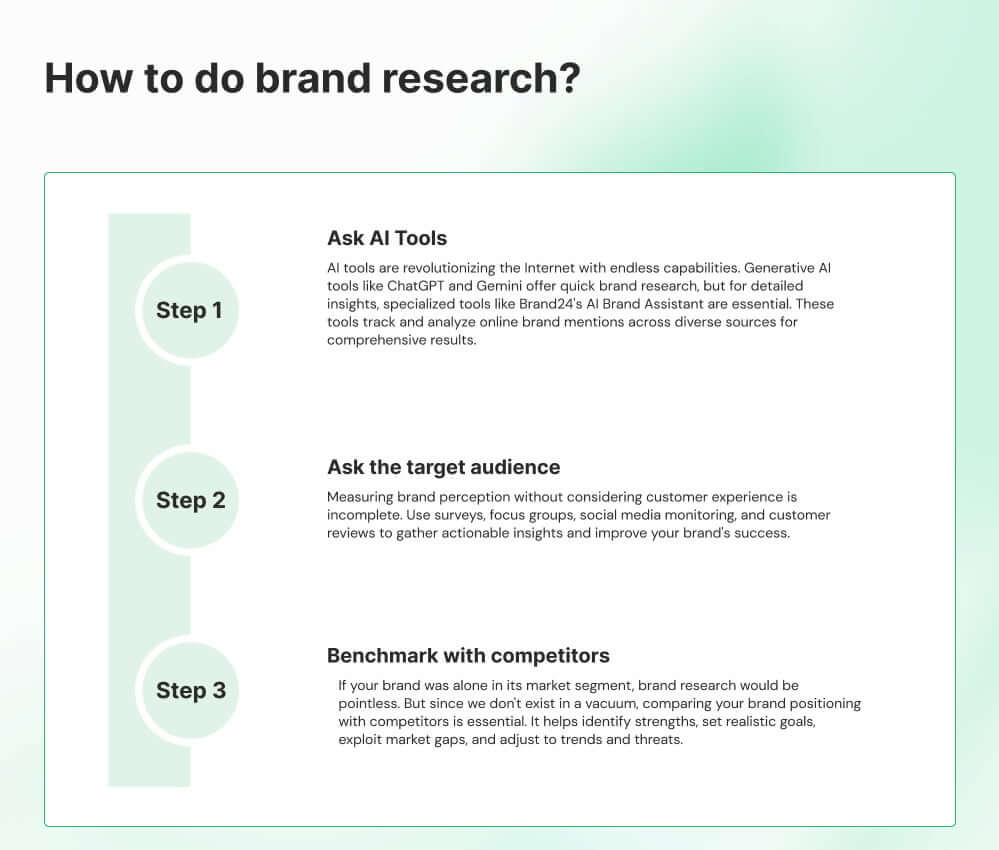
Step 1: Ask AI tools
AI-boosted tools are revolutionizing the Internet. You’re undoubtedly aware of that. Their capabilities are nearly endless. So, why don’t you start conducting brand research by using their powers?
I checked by myself that popular generative AI tools (like ChatGPT, Gemini, or Perplexity) can give you a really nice overview of your brand awareness and do the basic brand market research.
Like always, the key component is prompting the right questions. That way, you can conduct a pretty comprehensive brand research in a relatively short time (half an hour, maybe less!).
To picture it more clearly, I decided to conduct brand research for one of my favorite companies – Garmin.
If you’re unfamiliar with the name, Garmin is a brand known for its high-quality GPS navigation and wearable technology products for fitness, outdoor adventures, aviation, and marine navigation.
So, I asked ChatGPT, Gemini, and Perplexity some brand research questions to discover what information they could find online and how reliable these data are.
My sample question was: “What is the overall perception of the Garmin brand among consumers?”. All the answers were pretty similar because these generative AI tools are based on data from search engines.
That didn’t surprise me because all the abovementioned models access only publicly available information.
Nevertheless, I received some valuable insights based on data from reputable sources, such as Statista.
The real value of AI tools is that they can extract a genuine set of information and present it in an easy-to-digest form in a few seconds.
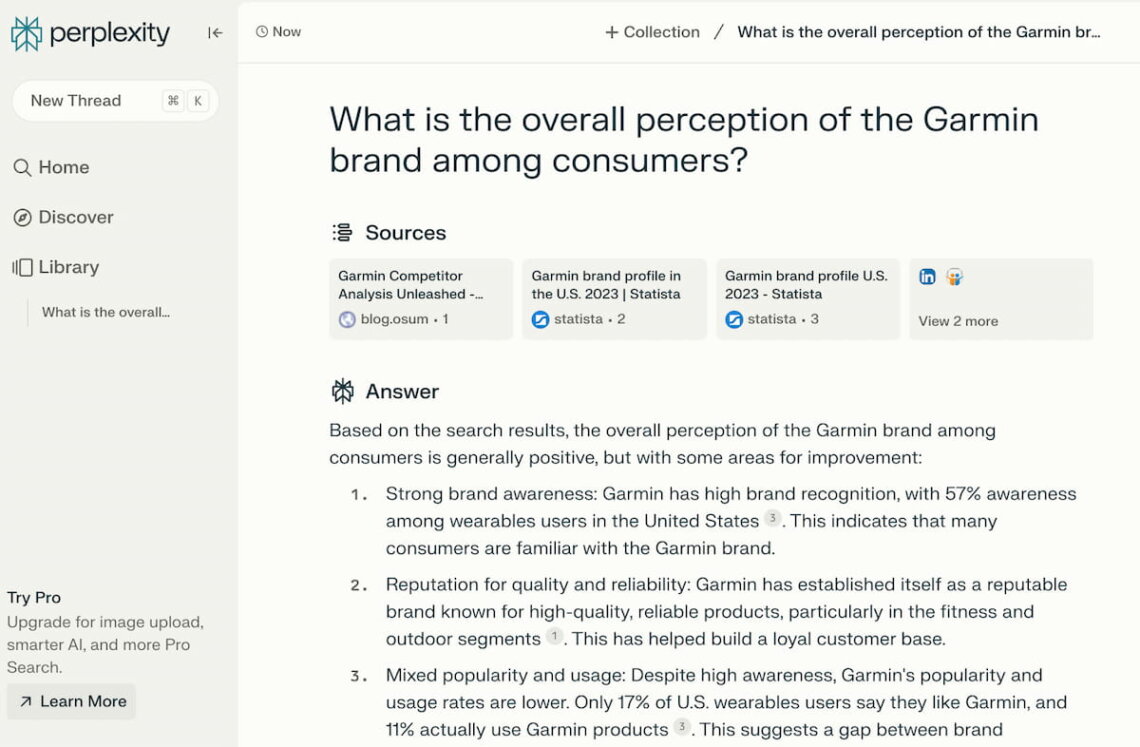
The main issue regarding widely available AI tools is that their brand analysis is sketchy. You don’t get any detailed internal data that usually makes the real difference.
That’s why you should seriously consider checking a specialized AI tool to uncover hidden layers of your brand perception. It will give you much more accurate and actionable insights.
Let me present one of those tools – the Brand24 and its AI Brand Assistant.
In short, Brand24 is a media monitoring tool that tracks, processes, and analyzes online brand mentions.
The undisputed strength making Brand24 unique is the number and variety of monitored sources. Namely, Brand24 tracks mentions published on:
- Social media platforms – Facebook, Instagram, Twitter (X), LinkedIn, TikTok, YouTube, Reddit, Twitch, and Telegram;
- Websites, blogs, forums, podcasts & video sites;
- Review sites and newsletters.
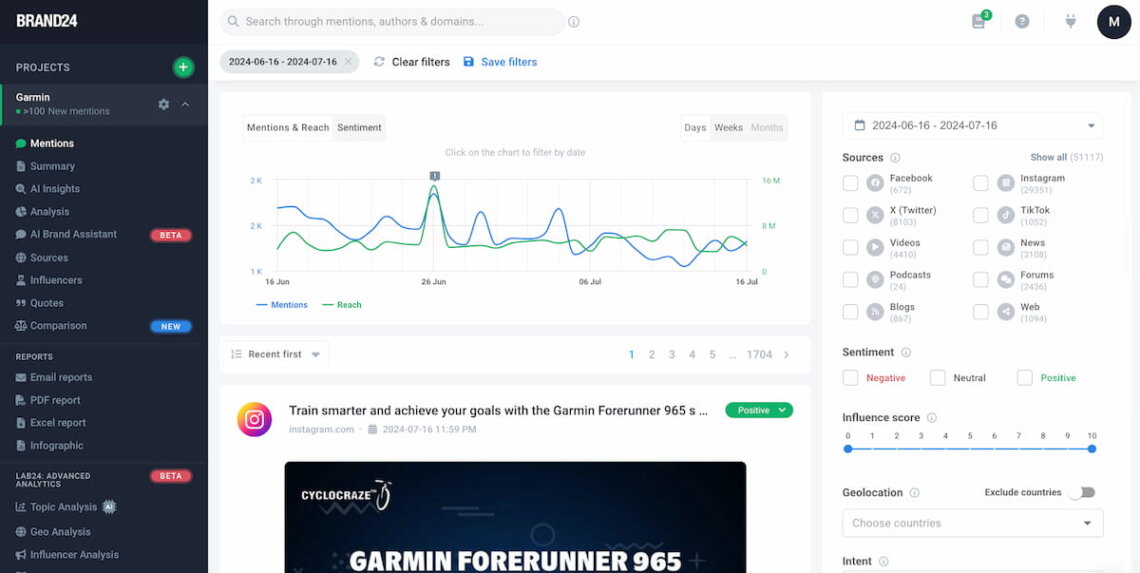
Try the best brand research tool!
In the case of brand research, the tool’s most exciting feature is AI Brand Assistant.
Long story short – as its name suggests, a Brand Assistant is your personal fellow who is always ready to help in your qualitative and quantitative research.
Brand Assistant is a chat and works like ChatGPT. But much better. Why?
As a part of the Brand24 toolkit, Brand Assistant sees all the information from your tracked projects.
Thanks to its machine learning and natural language processing core, the Assistant can analyze your project in the blink of an eye and present really personalized & actionable conclusions.
Therefore, the Brand Assistant is a ChatGPT enriched with internal project data. Honestly, it’s a game-changer for brand research!
Let’s get into practice!
To show you the difference, I asked the AI Brand Assistant precisely the same question as widely available AI tools: “What is the overall perception of the Garmin brand among consumers?”.
The Brand Assistant’s answer is on an entirely different level of specificity.
I got details such as the precise number of brand mentions, their reach, sentiment analysis, daily & weekly trends, and much more.
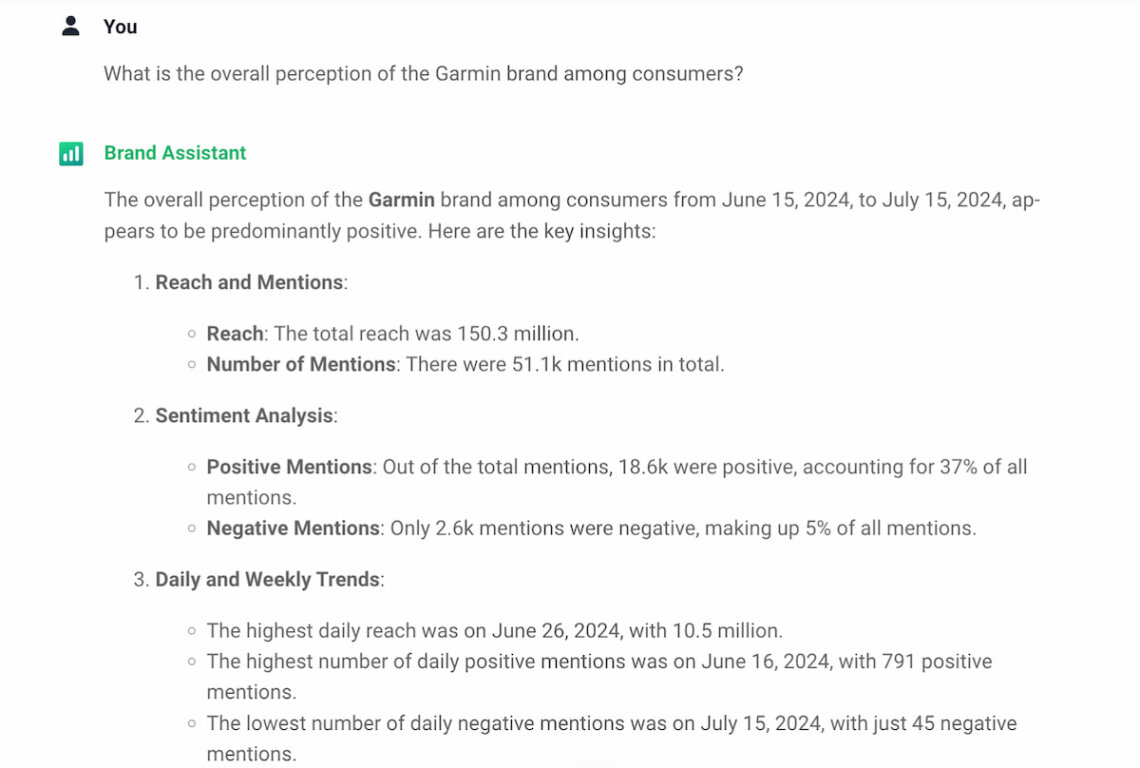
I love making people’s lives easier.
Therefore, here is the list of the top 15 prompts you can type in Brand Assistant chat to do the comprehensive brand research (of course, use your brand name instead of Garmin!).
Brand perception and brand awareness:
- What are the most common keywords and phrases used in online conversations about Garmin?
- What is the demographic breakdown of users mentioning Garmin (age, gender, location)?
- Can you provide a sentiment analysis breakdown for Garmin mentions over the past month?
Customer satisfaction and needs:
- What are the top 5 most frequently mentioned positive aspects of the Garmin brand?
- What are the most common complaints or negative mentions about Garmin products or services?
- What features of Garmin wearables and GPS devices are most frequently discussed online?
- Are there any emerging trends or unmet customer needs related to wearables or GPS technology that Garmin could address?
Brand strategy and future outlook:
- Which social media platforms generate the most engagement for Garmin?
- Who are the top 5 influencers mentioning Garmin, and what is their reach?
- Are there any influencer marketing opportunities Garmin could leverage to reach new audiences?
- Based on the online conversation, what are some potential growth opportunities for the Garmin brand?
- What are the latest industry trends affecting Garmin’s market position?
Competitive edge:
- How does the online conversation about Garmin compare to its main competitors (e.g., Apple Watch, Fitbit)?
- What are the strengths and weaknesses of Garmin’s main competitors in the wearables and GPS market, as reflected in online conversations?
- Are there any successful marketing campaigns by Garmin’s competitors that we can learn from?
Now, it’s time to prove that Brand Assistant will help you gain insights.
According to my personal AI apprentice, the top 5 most frequently mentioned positive aspects of the Garmin brand (question no. 4) are ease of use, fitness & health tracking, battery life, durability & quality, and innovative features.
In practice, you can use those traits by exposing them to the public, like: “Look! People appreciate us!”.
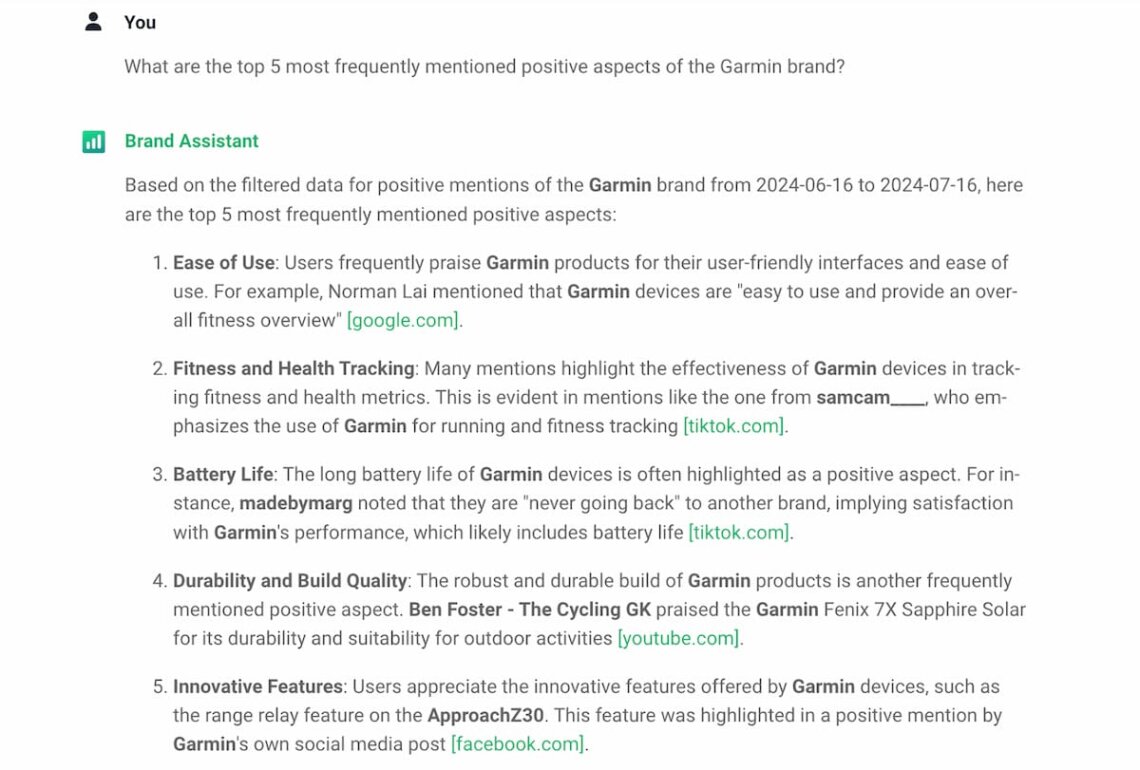
Ask a Brand Assistant for whatever you want! He knows the answer!
Step 2: Ask the target audience
The second technique of brand research is more direct and focuses on the first-hand opinions of your target audience.
All in all, how would you get your full brand image without knowing what your actual or potential customers really think about your brand, product, or service?
The answer is simple – measuring brand perception without considering customer experience is incomplete. Understanding where your brand stands in the eyes of your customers is more than necessary.
Direct customer feedback from your audience helps you understand the real-world brand positioning, preferences, and pain points that drive customer behavior.
Such an assessment can reveal hidden issues, check how the reality meets your expectations regarding brand experience, and highlight improvement areas to boost your brand’s success.
Okay, but how do you do it in practice? Here is the short list of rules to follow:
- Conduct survey research – design targeted questions about your brand to gather specific customer feedback. Include questions that measure brand recall to understand how well your brand is remembered;
- Organize focus groups – bring together small groups of customers to discuss their brand perceptions and experiences;
- Use social media monitoring – social listening is perfect for assessing your brand visibility and understanding sentiment toward your brand;
- Encourage customer reviews – to gather authentic opinions and boost your overall brand positioning.
Try the best brand research tool!
Step 3: Benchmark with competitors
Brand research would be pointless if your brand were alone in its market segment. But we don’t exist in a vacuum.
Therefore, you should end up conducting brand research by comparing your brand positioning with your competitors.
Understanding how your brand stands against the others is crucial for several reasons. It helps you:
- Spot what you’re doing well and where you should implement improvements;
- Set realistic goals and benchmarks for your brand;
- Notice market gaps to exploit;
- Discover market trends & potential threats and adjust your marketing strategies.
How do you do competitive benchmarking in practice?
The best advice I can give you is – again – to use the Brand24 tool.
Among dozens of features, this media monitoring software offers a Comparison Tab that summarizes competitive projects.
Let’s go back to our Garmin example. I decided to set this brand aside one of its primary competing brands – Fitbit.
As you can see below, Garmin literally crushes Fitbit in all categories. However, it’s worth noticing that Fitbit is doing really well in non-social sources.
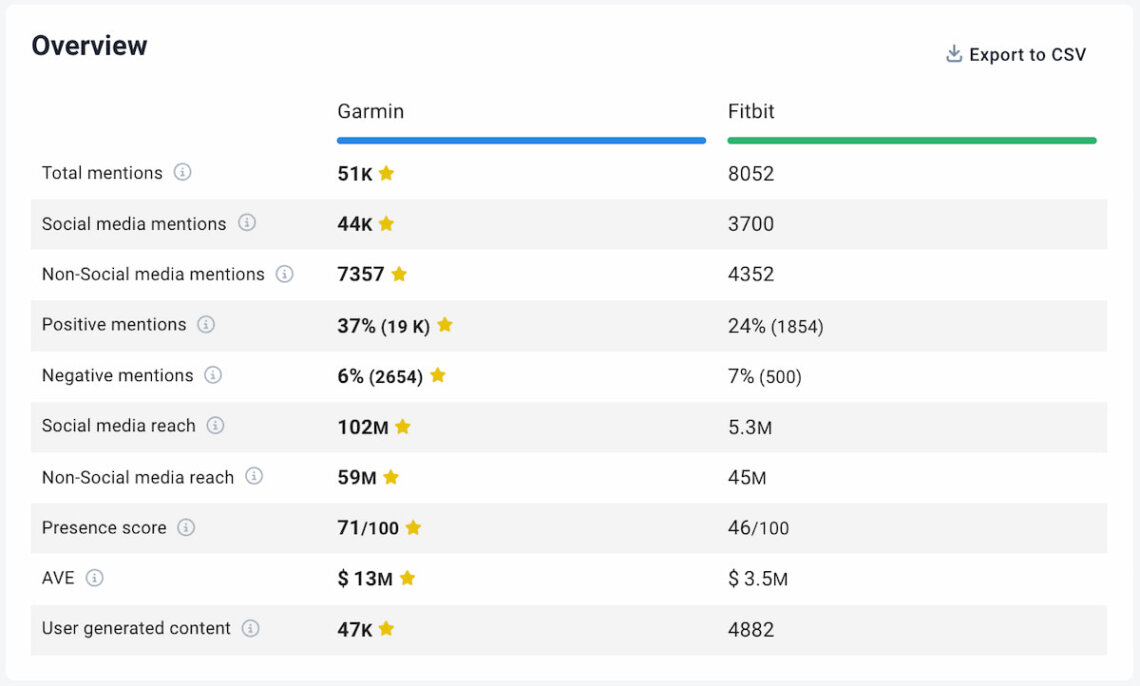
Curious about the key players in the market?
Check marketing insights out using the Brand Checker.
Wanting to deepen my analysis, I asked the AI Brand Assistant a follow-up question about these two brands.
The top three conclusions from a competitive analysis of Garmin and Fitbit are that Garmin has a much more robust online presence, the brand has higher user satisfaction, and influencer engagement in their products is more effective.
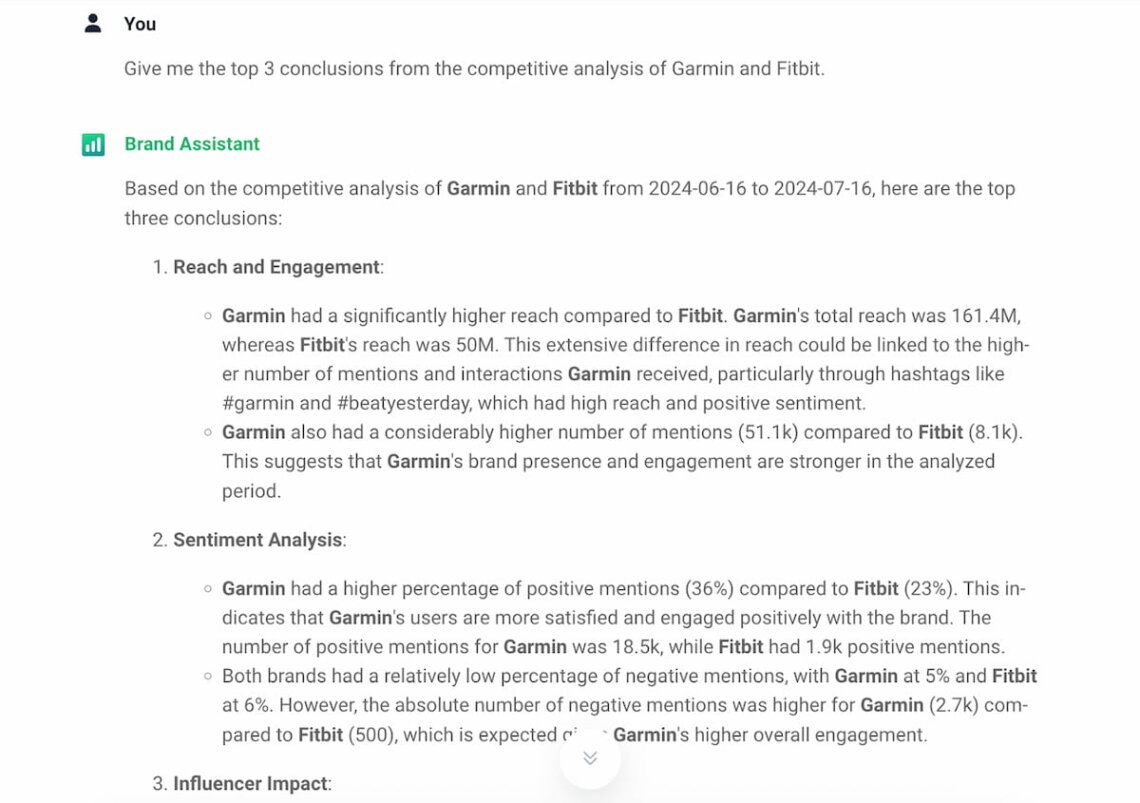
One more example. I wanted to know what are the top 5 Garmin influencers and their reach (question no 9).
Obviously, Garmin should head towards cooperation with YouTube creators!
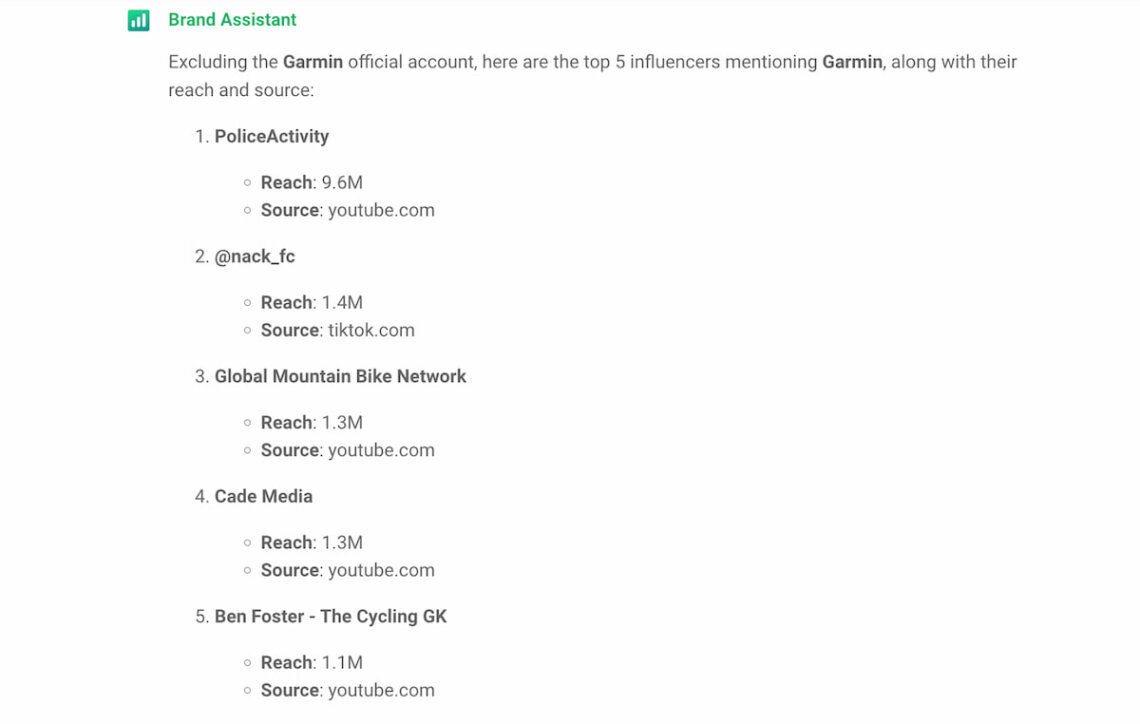
Brand Assistant on the wall, how’s my brand health after all?
Conclusion
Brand research is a process that allows you to discover the actual perception of your brand.
At first glance, it may seem quite monotonous. However, the existing AI tools can streamline the whole process of conducting brand research, making it both fruitful and exciting!
Besides widely available tools like ChatGPT or Gemini, you can also try specialized software like Brand24 and its AI Brand Assistant to get more deep-down insights.
Additionally, use the power of market research surveys and competitive benchmarking to get a broader picture of your brand.
Final thoughts:
- Ask targeted questions and compare your brand to competitors to comprehensively understand your brand positioning.
- Direct customer feedback is crucial for identifying strengths and weaknesses.
- Implement best practices in surveys and social listening to refine your strategy.
Research your brand like a pro! Sign up for the Brand24 free trial and check your brand associations yourself!




